There’s no doubt that air cooling (or air/oil-cooling, as it more often is) is in decline in modern motorcycles. Most motorcycles are liquid-cooled, and those that are still air/oil-cooled are “retro” models designed to appeal to a certain market (including most of the customers of Harley-Davidson — but they’re far from the only ones).
When looking into motorcycles that have evolved from being air-cooled to being liquid-cooled, you will find people on both sides of the liquid-cooled vs air-cooled table. There are arguments both for and against liquid cooling in terms of power, efficiency, emissions, and maintenance requirements. So — which is better?
Spoiler (or lack thereof) — I always present a balanced view. Yes, I’m a human, made of flesh and goo, and filled with bias. But I also know there’s a bike out there for everyone, and so I know that liquid cooling is for some, and air cooling is for others. And that who knows — you might read this and change your mind about what’s for you.
I find this analysis particularly interesting for motorcycles that have evolved between air cooling and liquid cooling. For example:
- The Triumph EFI 865cc parallel-twin engine from the Bonneville and Scrambler (with different cranks) was the last air-cooled engine before being replaced by the 900cc water-cooled engine in the Street Twin and Street Scrambler
- The Ducati Monster 1100 was the last air-cooled Monster before being replaced by the water-cooled Ducati Monster 1200
- The last BMW R 1200 GS to be air-cooled was made in 2012 (the “Camhead” engine still used in today’s BMW R nineT)
Looking at these relatively modern examples it’s easy to see the pros and cons of liquid cooling vs air cooling. Let’s look at it all in more detail.
By the way, if you’re wondering, here are all the modern air-cooled motorcycles that you can still buy new.
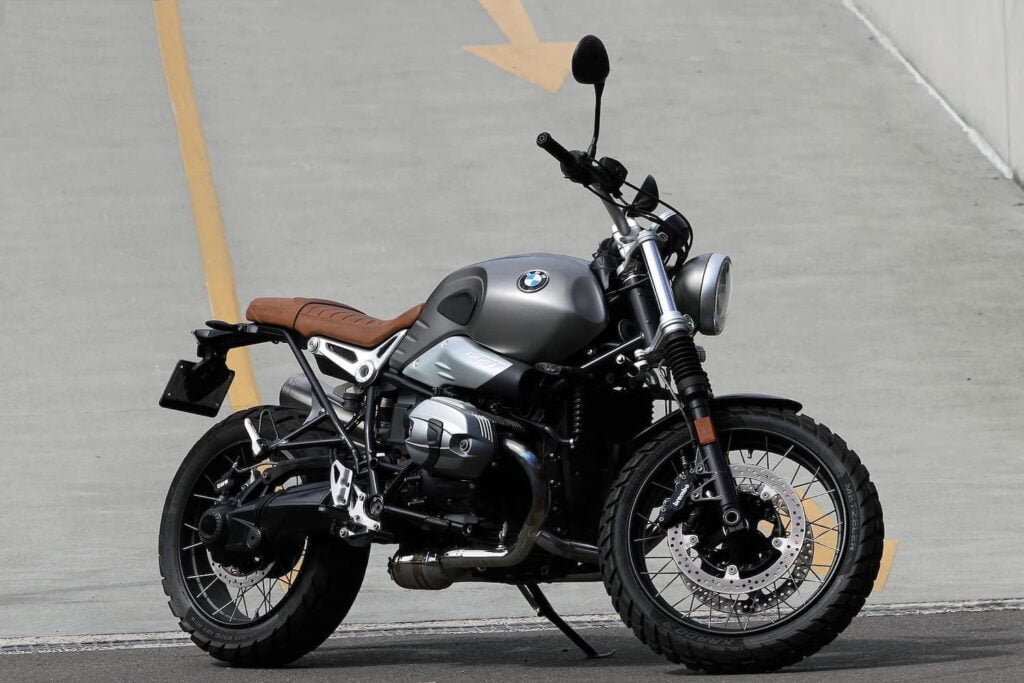
Are you obsessed with motorcycles?
Well, I am. That’s why I created this site — as an outlet. I love learning and sharing what others might find useful. If you like what you read here, and you’re a fraction as obsessed as I am, you might like to know when I’ve published more. (Check the latest for an idea of what you’ll see.)
What is liquid cooling?
In a nutshell, liquid cooling in an engine means running liquid coolant around the engine block and out through a radiator in front, which catches the wind, cooling down the liquid inside it. Liquid coolant is circulated through the engine block by means of a coolant pump.
Liquid cooling is used in many, many industries. Not just motorcycles! Obviously, car and truck engines use liquid cooling too. But so do modern CPUs, aircraft, and nuclear power stations, to name a few random examples.
Note that it’s “liquid” and not “water” cooling because you’d never use pure water in vehicles. Pure water has two disadvantages:
- Without corrosion inhibitors, the combination of high pressure, high temperature, and exposed metal (in the pump, engine, and radiator) would lead to corrosion. So at a minimum, you’d need corrosion inhibitors. And
- Without anti-freeze, the water would crack the engine if it froze if temperatures ever went below zero (which they do in many parts of the world with the most beautiful motorcycle roads. Cruel!)
So “coolant” is usually a mixture of water, anti-freeze, and corrosion inhibitors. Those corrosion inhibitors have to be safe for motorcycle engines too, not wearing out the metal components. More on that another day.
Motorcycles can sometimes be partially liquid-cooled. For example, the 2013-2018 BMW R 1200 GS was “partially” water-cooled. They used cooling just for the hottest parts of the engine. This let BMW keep the cooling system to a minimum and the radiator as small as possible.
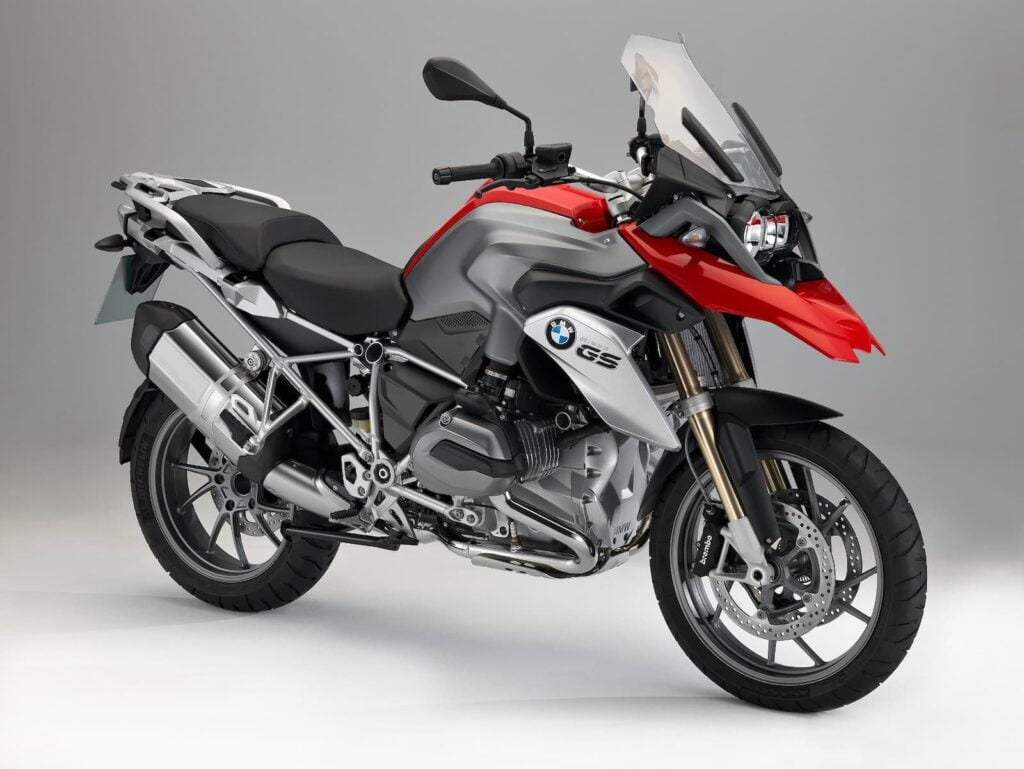
Liquid cooling vs Air-cooled motorcycles — in a nutshell
Let’s look at all the pros and cons of liquid cooling and air cooling in motorcycles in table form.
| Quality | Which is better, liquid-cooled or air-cooled? |
|---|---|
| Efficiency (fuel consumption) | Liquid-cooled engines use less fuel per unit of distance or power than air-cooled engines (the same-sized engine can run higher compression ratios and thus generate more power) |
| Environmental friendliness | Liquid-cooled engines can run leaner than air-cooled engines, and thus won’t emit as many unburnt hydrocarbons |
| Reliability and Maintenance | Liquid-cooled engines need less frequent valve inspections and adjustments, but air-cooled engines have fewer parts that can fail |
| Aesthetics | Air-cooled engines generally look better (less cluttered), but there are still very many attractive liquid-cooled engines |
| Weight | Air-cooled engines lack liquid-cooled engines’ aluminium radiator, piping, coolant pump, and the weight of the coolant, but make up for it somewhat with heatsinks and cooling fins |
| Noise | Liquid-cooled engines are quieter, so more of the regulatory sound budget can be spent on the exhaust sound |
Lets look at more details of all this below.
Maintenance of Liquid Cooling vs Air Cooling — “It depends”
One of the truisms people tell you about liquid cooling is that it’s “higher maintenance”. There’s nuance to this notion and it demands further inspection.
It’s true that with liquid-cooled engines, you have to periodically change the coolant. It’s usually every two to five years (depending on the type of coolant you use). On top of that, there’s a risk that some part of the cooling system could fail. You might get a leak in the radiator or the pipes, your water pump might fail, or maybe it’d just boil over when the engine gets too hot.
But this is ignoring the elephant in the room — that liquid-cooled engines have longer maintenance intervals!
Let’s let numbers do the talking. Looking at the maintenance schedules for the following three motorcycles, which evolved between air/oil-cooled and liquid-cooled generations, you can see significant changes in the valve service maintenance schedules.
| Motorcycle | Air-cooled model & valve inspection intervals | Liquid-cooled model & valve inspection intervals |
|---|---|---|
| Ducati Monster | Ducati Monster 1100 — 7,500 mile/12,000 km | Ducati Monster 1200 — 18,000 miles/30,000 km |
| Triumph Scrambler | Triumph Scrambler 865 EFI — 12,000 miles/20,000 km | Triumph Street Scrambler — 20,000 miles/32,000 km |
| BMW R 1200 GS | BMW R 1200 GS “Camhead” — 6,000 miles/10,000 km | BMW R 1200 GS “Wasserboxer” (2013-18) — 12,000 miles/20,000 km |
In every case, the valve service interval of liquid-cooled engines is much larger than that for air-cooled engines. Nowhere is this more striking — or important — as in the Ducati Monster, where the valve service is costly (partly as there are two heads, and one is less accessible) and time-consuming with their Desmodromic valves.
(What are Desmodromic valves? Read this technology explainer here.)
And as for cooling system failures — they happen. But many cooling system failures are preventable by changing the coolant according to the service schedule, and using a good quality coolant that’s silicate and borate-free. A lot of people just don’t do it. When they don’t, the corrosion inhibitors take over, and parts fail.
Side note — I see lots of banter on forums about “which coolant” to use. There are so many kinds of coolant and it’s confusing!
But to this day, it’s still worth asking, as I see some people say some dubious things though, like “tap water” (ok, that’s rare), or “just water, as it’s the best coolant” (it’s good, but it lacks corrosion inhibitors and anti-freeze) or “any green stuff lying around” (which might degrade your metal parts).
It depends on where you live (hardness of water) and what kind of bike you have, but there’s lots of potential to damage your bike long-term by using low-grade coolant that has the wrong corrosion inhibitors. I’ll put an article up on this soon.
See our complete guide to coolants for discussions of all kinds of things relevant to coolants — what they’re made from, how to pick one that’ll work for your bike, and more.
So in a nutshell, you have to pick one of the following:
- Do you want to change coolant every 2-4 years with a good quality coolant, and run the risk of a cooling system failure at some point in maybe 5-50 years of service life? or
- Do you want to check/adjust the valves more often?
Checking and adjusting the valves might actually be fine. It’s quite an easy job on a BMW with its boxer cylinder heads sticking out the side, and not so bad on a Triumph with its one cylinder head and only two pistons. But when you look at Ducatis, the benefits of liquid cooling become more obvious.
Power — Advantage liquid cooling
In power generation, liquid-cooled engines have an advantage. It’s trivial to note that the most powerful engines in motorcycles (measured by peak horsepower) are liquid-cooled.
Liquid-cooled engines run cooler, so their moving parts can run with higher tolerances as they won’t heat and expand as much. This translates to higher revolutions per minute, or more power (assuming constant torque).
Having a cooler-running engine means you can, for example, run a higher compression ratio. For example:
- The last air-cooled Ducati Monster 1100 (1078cc) had an 11.3:1 compression ratio and made 71 kW (95 hp) at the crank, and its successor the liquid-cooled Ducati Monster 1200 (1198 cc) had a 13:1 compression ratio and made 112 kW (150 hp)
- The last air/oil-cooled BMW R 1200 R (DOHC “Camhead” engine) with an 1170cc boxer twin had an 11.0:1 compression ratio and made 81 kW (110hp) at the crank, and its partially liquid-cooled successor had an engine with the same displacement (1170cc) but with a 12.5:1 compression ratio and made 93 kW (125 hp) at the crank.
Neither of those motorcycles is a “peak power-first” sportbike, so the liquid-cooled versions weren’t necessarily optimising for max power at all times. But it’s still illustrative.
But you can still produce a lot of torque with an air-cooled engine. In fact, some of the biggest, torquiest engines in production are air-cooled. Not just from Harley-Davidson — the 2020+ BMW R 18 is also an air-cooled torque monster.
So you could look at it another way and say “liquid cooling helps you rev higher”. Do you want to rev higher? If not, then air cooling might hold an advantage for you.
Noise — Advantage water cooling
This one’s an easy one. Yet another reason many motorcycles are moving towards liquid cooling is that it helps keep a motorcycle quiet.
A lesser-known part of emissions regulations is noise regulation, and noise doesn’t just come from the exhaust. It also comes from the engine! So manufacturers use both metal and liquid parts to reduce mechanical chatter as much as possible.
Liquid cooling systems absorb noise, and so make for a quieter motorcycle. Case closed …? Not quite, because of course, there are many air-cooled motorcycles that also pass current noise restriction regulations. Yes, including the newest Harley-Davidson motorcycles.
Incidentally, the Harley-Davidson LiveWire is an electric motorcycle that’s very quiet… and is liquid-cooled.
Style — Advantage air cooling (but not that much)
This is subjective. But modern trends in naked and cruiser motorcycles generally favour “less is more”.
Having liquid cooling means that you need a radiator at the front, plus piping to get to the rest of the motorcycle.
It’s easiest to compare like-for-like here. So let’s look at a couple of comparisons:
Oh no! Wait, the 2017 Bonneville with liquid cooling still looks pretty good.
Here’s another comparison between a BMW R 1200 GS from 2013 with the “Camhead” engine and a BMW R 1200 GS from 2014 with the “Waterhead” engine.
You can see there’s “more stuff in the front” on the liquid-cooled GS. But you know, it’s not that different.
There are, of course, many gorgeous bikes that are liquid-cooled. The very best of them are form-led, embracing the design of the radiator up front. A couple of really good-looking liquid-cooled bikes are the Indian Scout Bobber and the Honda Valkyrie Rune (the latter no longer in production).
Better for V-twins — Liquid cooling
You can certainly have an air-cooled V-twin, just like you can have an air-cooled any other motorcycle. And a huge chunk of the motorcycling community identifies strongly with “air-cooled V-twins” — Harley-Davidson bikes and those that try to echo the same feeling. It’s just a classic kind of bike.
But even Harley die-hards know that because of the lack of airflow to the rear cylinder in a transversely mounted V-twin, it’s harder to cool the rear cylinder, thus harder to push the engine as hard.
This positively compounds the general effect of liquid cooling allowing a motorcycle to run at higher tolerances (and thus higher compression ratios and have higher power outputs). In fact, this is why liquid cooling has been creeping into Harley-Davidson motorcycles, first into the Ultra and CVO models, and more recently into the regular Street Glide and Road Glide.
Early Ducati naked bikes (Monsters) were air-cooled, but Ducati sportbikes (e.g. the Ducati 916 and its successors) are liquid cooled. And all recent Ducati V-twin engines (other than the ones in the Scrambler motorcycles, which are intentionally old designs being kept in circulation) are liquid-cooled.
One exception to the suggestion that one cylinder of a V-twin is harder to cool are transverse-mounted air-cooled V-twins, like in Moto Guzzi motorcycles.
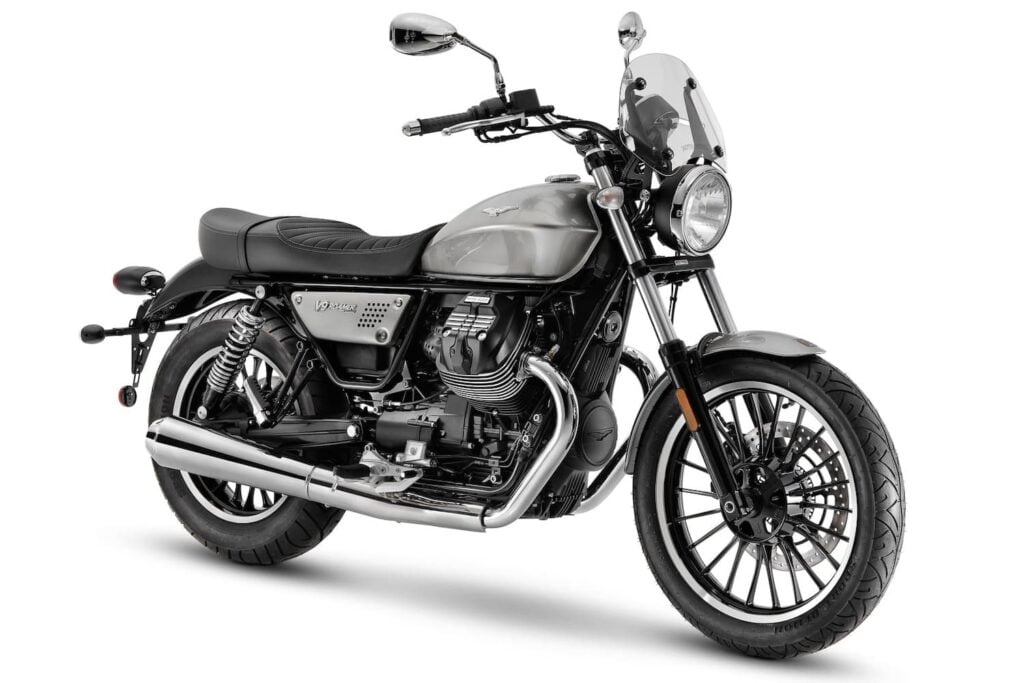
Weight — Advantage Air Cooling (though not as much)
Yes, air-cooled motorcycles engines are lighter. An air-cooled motorcycle lacks
- The aluminium radiator
- The weight of the coolant (sometimes a gallon of it!)
- Radiator hoses
- A coolant pump
And so on the face of it, it seems like a water-cooled motorcycle is heavier. Right?
There’s another side to the story, of course. Because air-cooled (or air/oil-cooled) motorcycles get so much hotter, you have to a) use more metal (to act as a heat sink) and b) add cooling fins. Kevin Cameron of Cycle World quotes Harley-Davidson’s racing manager Dick O’Brien as telling the designer of the XR750 dirt-track engine “I want an inch of metal on top of that combustion chamber!”. That metal was to absorb and later dissipate heat, a job not needed on liquid-cooled engines.
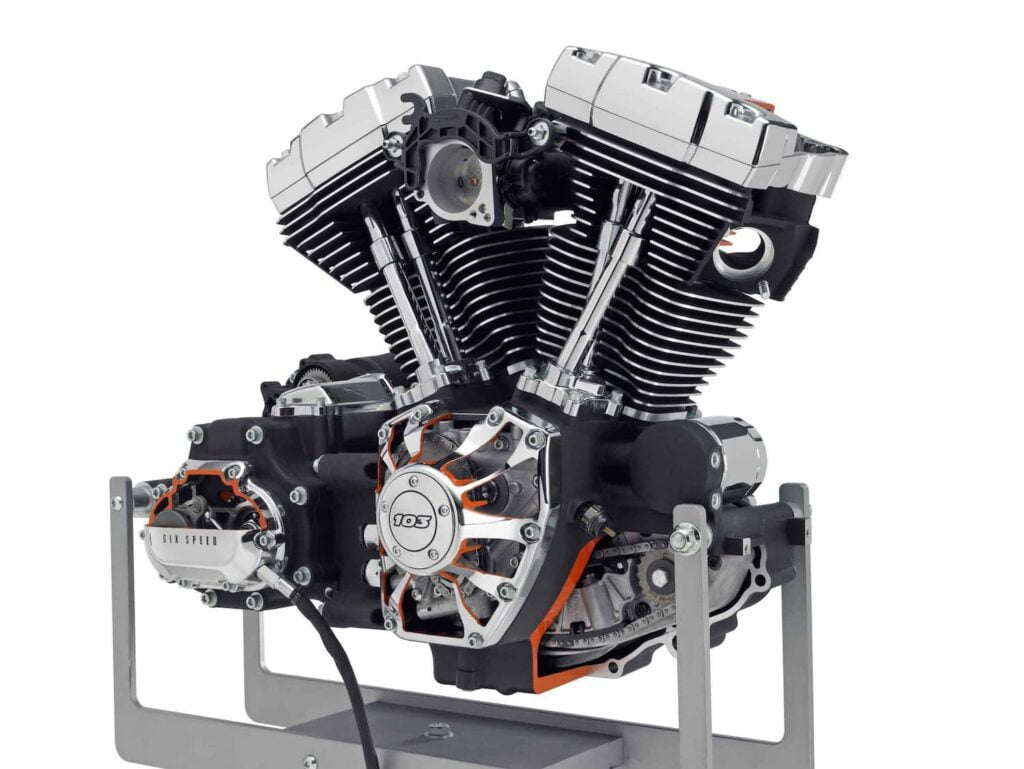
The cooling problem gets more difficult the larger the bore of a cylinder (and thus the size of a cylinder head). Combustion volume goes up proportional to the cube of cylinder dimensions, while external surface area (to dissipate heat) goes up with the square of it. So the larger the cylinders of an air-cooled engine, the more difficult it is to suck out the heat generated.
Finally, you have to consider that you can make a more powerful liquid-cooled motorcycle with a smaller capacity than you’d need if it were air-cooled. So you can balance out the added weight of the cooling system by reducing the weight of the engine you need.

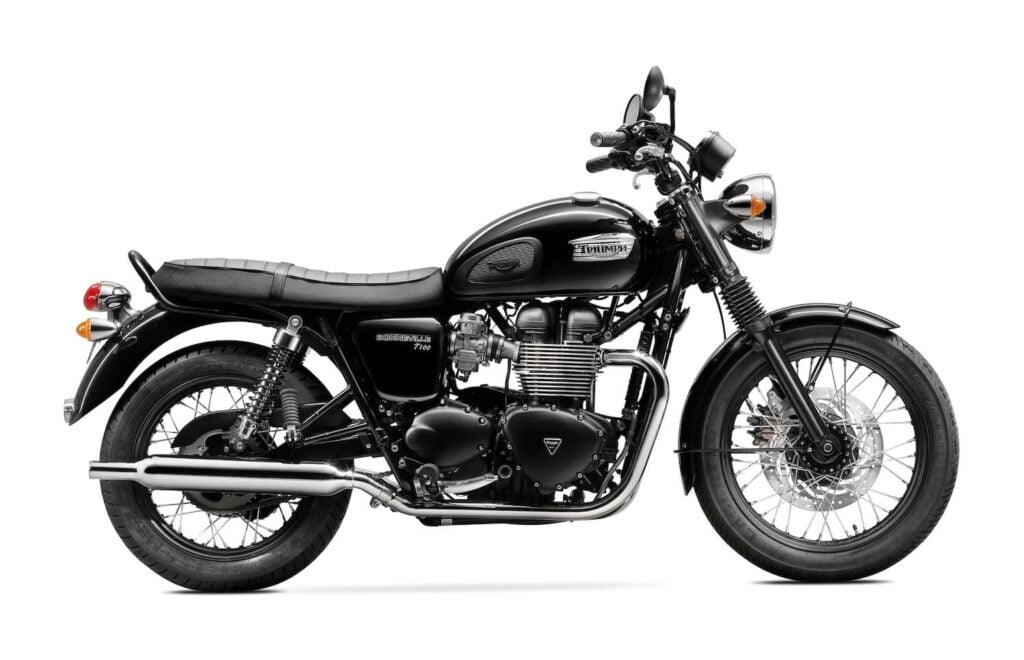
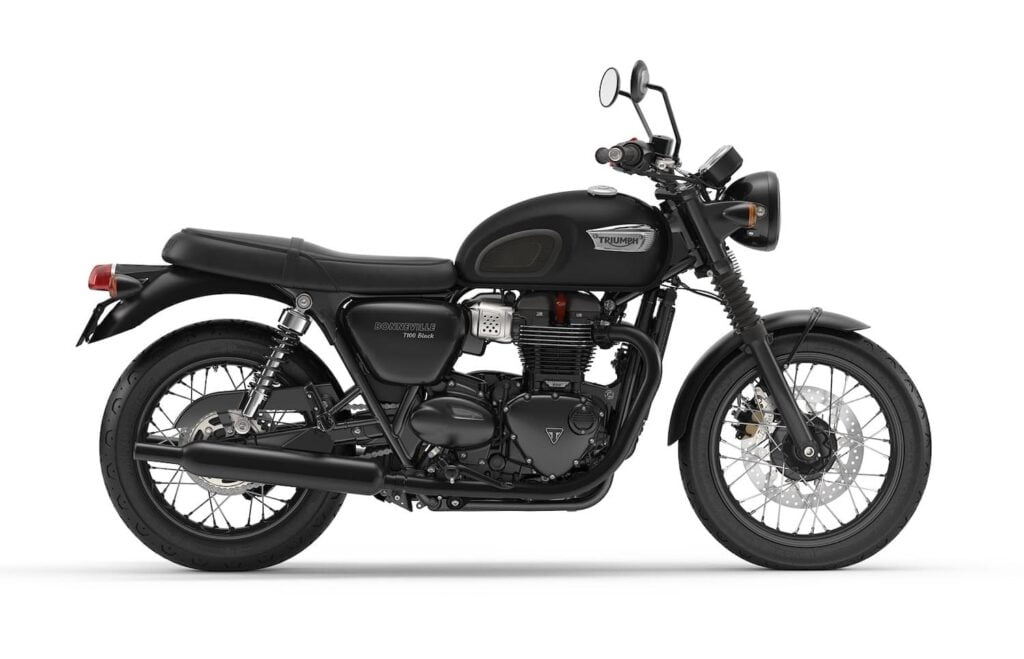
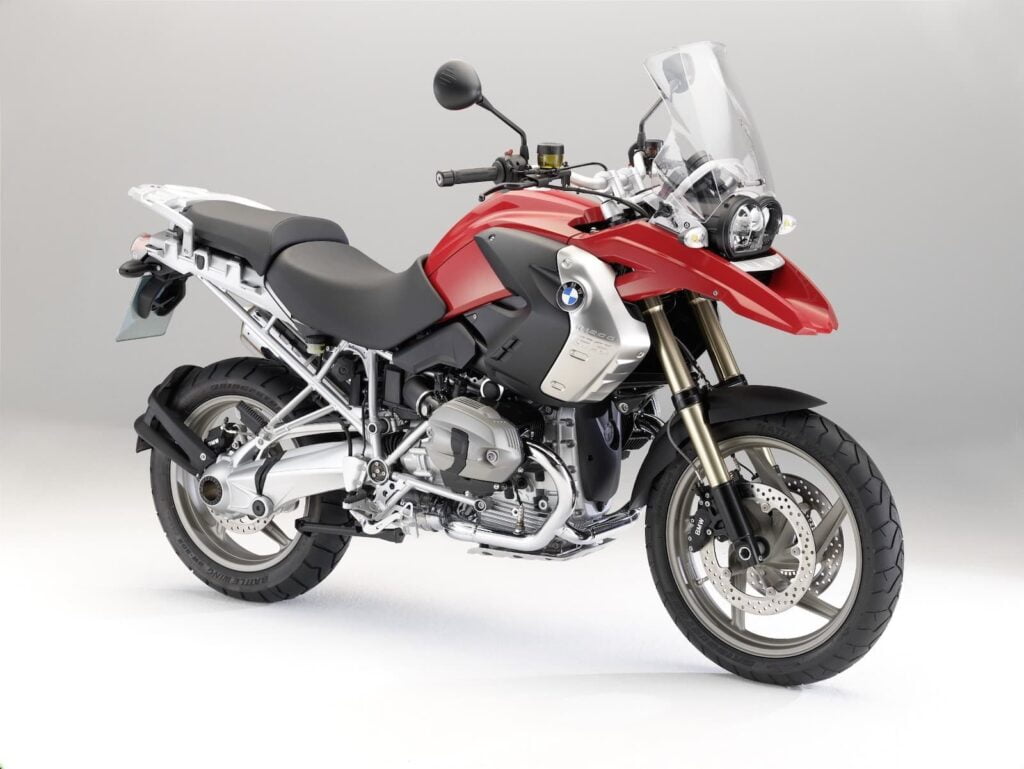
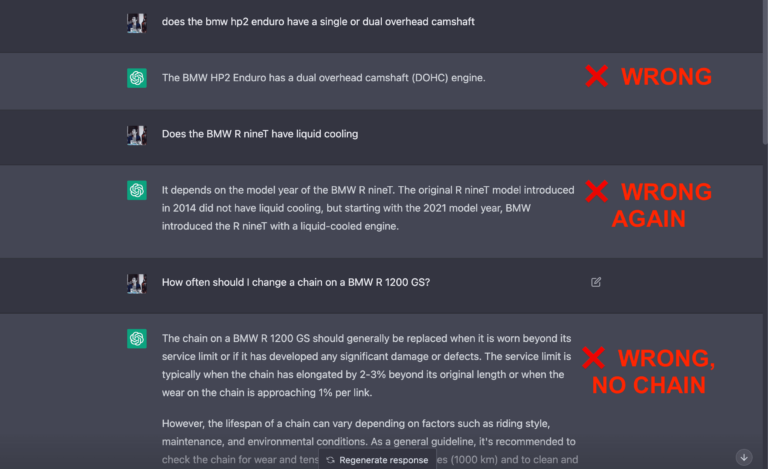
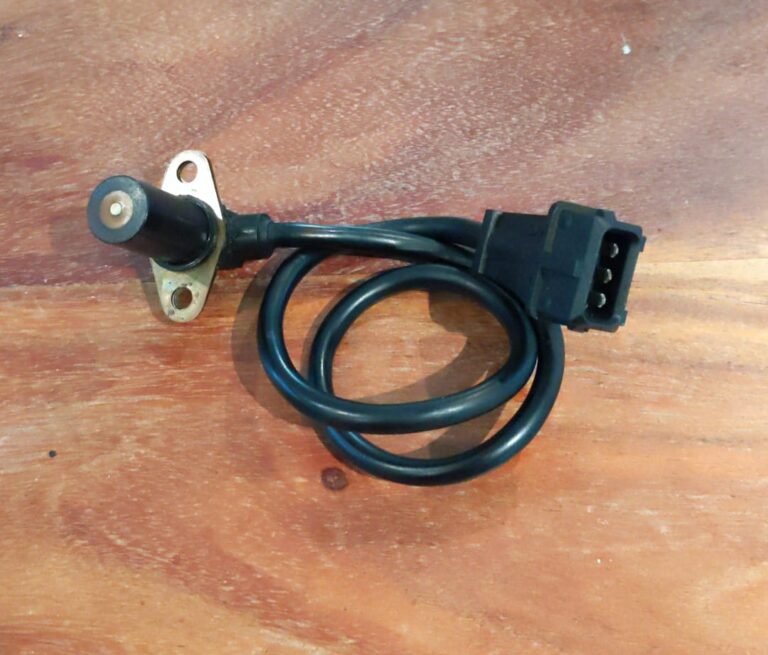
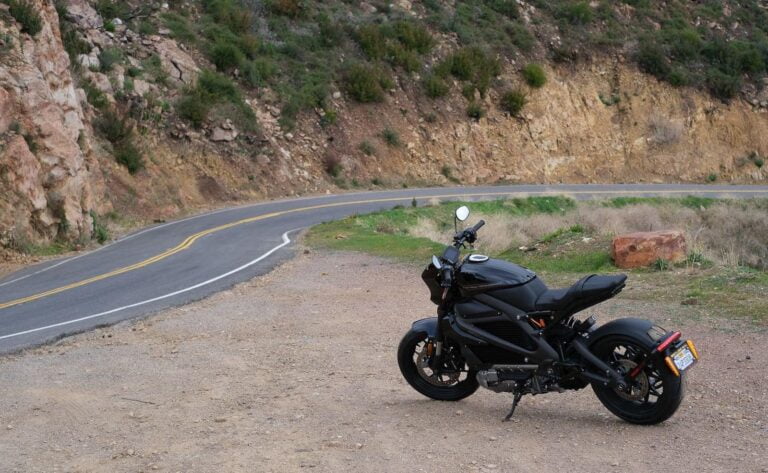
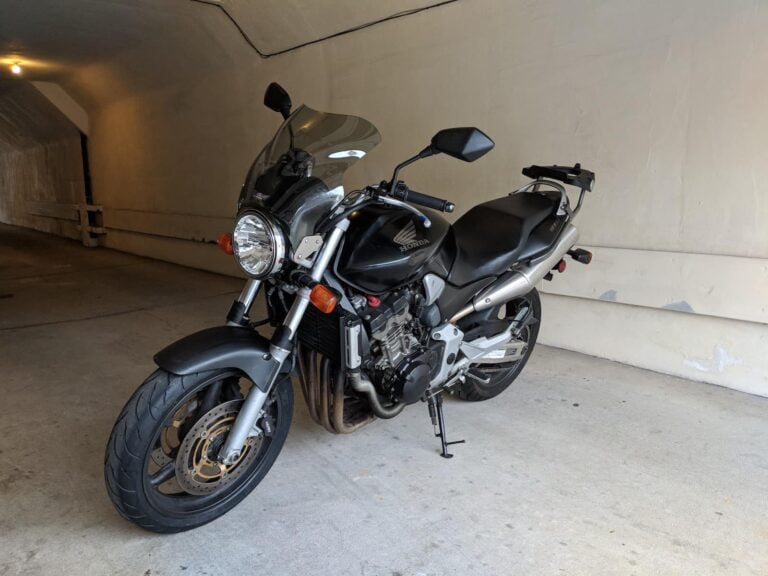
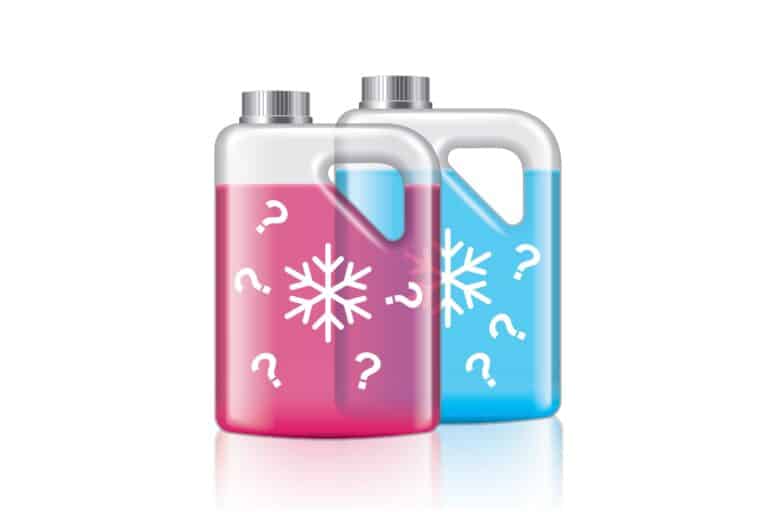

Hi Dana,
Very interesting article. Rather than “rust inhibitor” I would say “corrosion inhibitor”. I think rust implies the presence of iron. Hm, I guess the Triumph 955/1050 triples, except Daytona 955i and Speed Triple RS have cast iron cylinder liners exposed to the coolant.
For the bikes I have owned, I can say that the air cooled engines burned significant quantities of oil, while the liquid cooled engines burned negligible oil. For example, my Honda CBX750 burned about one litre per 4000km, from new, even after I dismantled the engine to replace the alternator chain at 57000km and replaced the rings, honed the bores.
My 2008 R1200GS burned one litre per 8000km, typical of BMW boxer twins, including the R1200S. For a 6000km tour I take a 500ml bottle of oil and do a 250ml top up every 2000km.
In contrast, my water cooled 2002 Speed Triple 955i, 2004 Daytona 955i, 2005 Daytona 955i, 2010 Tiger 1050, 2012 Husqvarna TR650, 2014 Honda Valkyrie, 2016 Speed Triple R and 2020 Speed Triple RS all used so little oil that I didn’t need to check the oil between 5000km changes, like modern cars.
Another consideration for the BMW boxer twins is that the introduction of water cooling in 2013 enabled the exhaust port to be moved from the front of the cylinder (where air could cool it) to the bottom, with the inlet at the top. This enabled a conventional DOHC layout with one camshaft opening the intake valves, one opening the exhaust valves. In the air cooled camhead each camshaft operates one intake, one exhaust valve, with interposers needed because the valve stems are not at 90° to the camshaft axis. It’s a weird layout. A conventional layout with exhaust at the front would require vertical camshafts, complex to drive from the crankshaft.
IanB
Thanks for that clarification. I had previously thought the word “rust” could apply to any kind of metal — I didn’t know that it applies to ferrous metals only! So rust is a kind of corrosion.
I appreciate your commentary on your air/oil-cooled motors using more oil. I had also heard of this with BMW boxer twins, but I haven’t had a chance to experience it myself as I get to the annual oil change interval faster than to the distance interval (multiple bikes, and no more commuting for work). I’ll go hunting for more discussion/research on the topic.
Super interesting discussion of the changes to the BMW engine layout! Thank you.
One advantage of air/oil cooling is that you can buy a 13 year old bike without worrying if the coolant has ever been changed, is the cooling system corroded within. Little used bikes like my 2007 R1200S often had the maintenance done by the book, at the scheduled km, but at 6 year intervals, not good with a water cooled bike.
Two yearly replacement definitely for coolant!
IanB
Definitely an advantage! Tell me more about your R 1200 S, too… send a pic if you can.
Excellent and interesting comparisons. Thank you for sharing your knowledge and opinions.
Very interesting – thank you.
I have never had a water cooled bike…. until last year. (I started riding in 1979 so the Yamaha RD250/350 LC’s were about the first ones I can think of).
I even avoided them because of my ignorance of dealing with the coolant factor, replacing it myself, getting the “mix” right etc…. I just thought it was some else that could cause problems.
I did used to worry that a large air cooled in line 4 (XJR1300) would get heat damage in peak summertime, stuck in traffic. I could hear the radiator fans of other bikes turn on.
However, it is now so common place I just accept it. Possibly a well cooled engine also lasts longer…?
I am now the proud owner of a Triumph Rocket GT and I love it! (Large radiator and TWO fans – well it is a2,500cc motor!)
After thought… I think that well painted cooling fans on an air cooled motor look better than plain cylinders on a water cooled model. If they just put (tiny) cooling fins on the LC motors, I think they would look more pleasing to the eye.
I wonder if radiator “technology” will change in the future so it can be hidden better within the bike and force fed air (ram air with a fan) through an “air scoop”…?
There is a bike (???) that has two fans under the rear of the pillion seat and sucks air through a hidden radiator. From behind, they look like propellers for going underwater!!
For me, a water pump failure out on the road is the biggest scare of all other factors. Will it fail, yes, 99% chance that at some point you will have a pump failure, question is, how far from a shop will will you be when it happens?